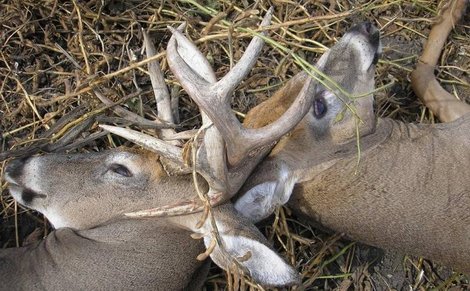
Each fall, as testosterone levels rise in white-tailed bucks they begin working off aggression by working rubs and building up much needed shoulder and neck muscles. It’s not an accident and if you’ve ever noticed the changes that a buck’s body undergoes between late August and late October, it really is amazing. However, as the breeding season — known as the rut by hunters — begins, whitetail bucks that were friendly towards one another during the antler growing period quickly become rivals. It’s all about a battle for space and access to receptive does.
The rut really takes its toll on bucks. Not only do bucks lose a substantial percentage of their body weight over the course of the breeding season, but buck to buck combat can lead to both direct and indirect mortality. Indirect mortality can come from wounds that become infected or even internal damage from fighting. Direct mortality, although more infrequent, can occur when two or three bucks’ antlers become locked together causing one or both animals to die.
This is the case today for one deer. I received these photos of two locked up white-tailed bucks from Minnesota. The guys that stumbled upon the bucks actually found them while one of the bucks was still alive. Instead of shooting the locked up buck, they managed to separate the two and send one lucky deer on his way. Here is the story:
I have an awesome story to tell you. Yesterday, (Friday, September 26) I got the privileged to help free a couple of locked bucks. Kale’s father-in-law saw the 2 bucks while doing his mail route. One was already dead and the other was still alive. We decided to throw a tarp on the live deer and then Adam and I held the buck down with a pallet, while Kale sawed the antler. Kale’s dad Les was helping and taking pictures.
We decided to cut an antler off the live buck in hopes that he would have a better chance at getting passed up being one racked. The dead buck is a nice 2 year old point, and the live buck we think might be a 3 year old with good mass but average tine length. Would have been fun to shoot the live buck but would not have been much for a story. Oh yeah, after the live buck freed himself, he went running away with the 20′ tarp caught in his rack, but then got it wrapped around his head 150 yards later and he fell down in the alfalfa. We then ran and grabbed the tarp and helped him free himself. It was an awesome experience. Enjoy the pictures.






My cousin found two bucks locked together, a 17 point and a 13 point. He ended up shooting one and his dad took the other. The green score on the 17 point was 201 gross, 195 net typical. The 13 point buck scored 155 gross, 139 net.
Good job guys! I bet he was glad to be free!
Why is it that some states count all the horns as one point and other states only count one side? — So when someone sees a comment such as the above 17 & 13 pt stories. How do we know for sure its a total count of all antler points on both sides? Granted it would be beyond comprehension to have 13/17 pts on one side, but you get the idea, right? Being from the south, I know we count all points, but northerners, such as say WA state, count only 1 side. To them an 8 point buck in TX is a 4 pointt in WA. Strange and can’t figure out why they are not all the same?
I suppose antler terminology is simply a local thing, but not sure why it developed differently with reference to antler points. In addition, some parts of the country call a 9 point buck a 4×5. There is different lingo no matter where you go — and it’s a lot like common names for plants. A pin oak is some areas is a water oak, but there is actually a pin oak, too. This happens with stuff all the time, but when in Rome do as the Romans do. Of course, maybe us Southerners are just showing off our countin’ skills.
I think the differecne in counting is based on species. I have always known whitetails to be counted as all points. However mule deer are say a 4X4, etc.